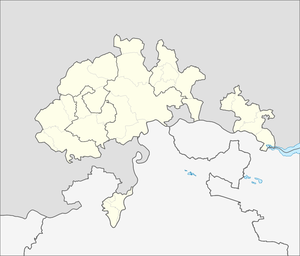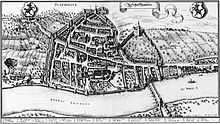Schaffhausen – Feuerthalen Rhine bridge
Coordinates: 47 ° 41 ′ 41 " N , 8 ° 38 ′ 26" E ; CH1903: 690 225 / 283,356
|
Schaffhausen – Feuerthalen Rhine bridge |
||
|---|---|---|
| use | Road bridge | |
| Convicted |
Hauptstrasse 13 Hauptstrasse 14 Hauptstrasse 15 |
|
| Crossing of | Rhine | |
| place | Schaffhausen and Feuerthalen | |
| construction | Prestressed concrete bridge | |
| overall length | 102.5 m | |
| width | 19.5 m | |
| Longest span | 61 m | |
| building-costs | 7 million SFr | |
| start of building | 1962 | |
| completion | 1965 | |
| location | ||
|
|
||
The Rheinbrücke Schaffhausen – Feuerthalen , also popularly known as the Feuerthaler Brücke , is a road bridge that spans the Rhine in Switzerland and connects the city of Schaffhausen in the canton of Schaffhausen with the municipality of Feuerthalen in the canton of Zurich . The current structure dates from 1965. Main streets 13 , 14 and 15 lead over the bridge with two lanes in the direction of Schaffhausen and one in the direction of Feuerthalen, as well as pedestrian and cycle paths on both sides . The bridge is owned by the canton of Schaffhausen, on whose territory the bridge, with the exception of the southern abutment , is located. The bridge has underpasses for pedestrians and cyclists at both ends. Among other things, the national Rhine route No. 2 Andermatt - Oberalppass - Chur - Schaffhausen - Basel (424 km) from Veloland Schweiz runs under the bridge.
First river crossings
It is certain that there was already a crossing of the Rhine in the form of a ford near Schaffhausen at the time of the Gauls . A Rhine bridge was first mentioned in a document in 1259, the construction of which was probably commissioned by the abbot of the Allerheiligen monastery . The narrow, covered wooden walkway was destroyed in the early summer of 1480 by a flood. The wooden successor building is documented for 1489. This was replaced between 1550 and 1611 by a stone arch bridge with eight openings. However, the stone bridge was often damaged due to technical defects. Floods destroyed the pillars, two collapsed arch openings had to be replaced by a covered wooden bridge and on May 3, 1754, a flood caused the piers to collapse completely. Only one pillar remained.
Pitman Bridge
On October 2, 1755, the Schaffhausen city council commissioned the builder Hans Ulrich Grubenmann to build a wooden bridge. The city council rejected the construction proposed by Grubenmann with a span of 119 meters. He did not trust the pillarless construction. Instead, a bridge using the existing pillar in the Rhine and spans of 63 and 56 meters was implemented. The wooden bridge, covered with 400,000 shingles from the Black Forest , had a clear width of 4.5 meters and a free height of 5 meters between the supporting structure and laterally arranged trusses . The wood used for the construction, 20 extra large fir trees (also called doll trees) and 400 normal fir trees, were felled in the Bregenzerwald and loosened to Schaffhausen . The building was opened on October 2, 1758. On April 13, 1799, French troops retreating from the battle of Stockach, which they lost in the Second Coalition War , destroyed the third bridge over the Rhine by a fire. The original model of the bridge can be seen in the Museum zu Allerheiligen in Schaffhausen.
A legend tells that Grubenmann disregarded the requirements of the city council regarding supporting pillars. The bridge was designed in such a way that it would have been stable even without supporting pillars. When the bridge was opened, Grubenmann knocked away the wedges between the bridge and the pillar and said: "There you have your pillar, but I have my bridge."
The story belongs in the realm of legends, because the building that was built had a slight kink in the floor plan due to the shared use of the old pillar. Without this pillar, the bridge would not have withstood the forces. However, despite the central pillar, the bridge also had continuous structural parts. These will be seen on the one hand as a remnant of the previous draft without a central pillar and on the other hand due to the fact that Grubenmann worked purely based on empirical values and was not yet familiar with any calculation methods.
Fourth wooden bridge
In 1804, Schaffhausen commissioned the foreman Andreas Widtmer to build the fourth and last wooden bridge over the Rhine. The open wooden bridge was 8 meters wide between the railings and spanned the Rhine with seven arched openings that rested on pile yokes. Every 7 to 20 years major repairs had to be carried out, which were financed by a bridge toll until 1850.
New building in the 20th century
The old wooden bridge was no longer able to cope with the steadily increasing motor vehicle traffic in the 1950s. Therefore, the planning of a new building was started. At the same time, the new construction of the Schaffhausen power plant was planned to replace the almost 100-year-old Moserdamm . The planned damming of the Rhine made it necessary to redesign the entire bank of the Rhine to Stemmer . The Rheinuferstrasse in the south of the old town was created as a feeder from Neuhausen am Rheinfall . Thanks to the new Rhine regulation by the power plant, the Rhine has the same water level in every season. This made it possible to lower the bridge. In the design, however, the engineers had to take into account the requirement that the bridge could be raised in the event of any navigation on the Upper Rhine. Shortly after the bridge was opened, the plans to make the High Rhine navigable were finally abandoned. All of the previous bridges led to Freie Platz. The new building was used to change the flow of traffic. The obliqueness of the bridge to the direction of flow resulted from the displacement of the abutment on the Schaffhauser Ufer by 50 meters downstream. The structure was built between 1962 and 1965 and cost 7 million francs.
Until the opening of the A4 city passage and the A4 cable-stayed bridge in 1995, a large part of the road traffic between Stuttgart and Zurich led over the new bridge. After that, the traffic subsided noticeably. In 2009, an average of 19,000 vehicles passed the bridge every day, and the trend is rising again. In 1986/87 the Rhine bridge was renovated for the first time for 1.35 million francs. A total renovation including the utility lines laid in the bridge is planned for 2011/12. It is expected to cost around 5.6 million Swiss francs. After the renovation, the engineers assume a remaining useful life of 60 years.
The 102.5 meter long bridge was built as a prestressed reinforced concrete bridge . It has three openings and a center span of 61 meters. In the transverse direction there is a three-cell box girder cross - section , which is 1.28 meters in height in the middle of the bridge and 1.83 meters above the river piers. The superstructure rests on two narrow, disc-shaped pillars. They are founded on concrete piles up to 20 meters deep in the river bed. The large abutments have a flat foundation . The carriageway slab is 19 meters wide and is divided into three lanes with a total of 13 meters wide and two sidewalks, each 3 meters wide.
literature
- Martin Schweizer: The Feuerthaler Brücke will be renewed in Schaffhauser Nachrichten on September 17th, 2010
- Hans Rudolf Stierli, Erwin Stucki, Paul Wüst: Before the construction of the N4: the Rhine crossings between Stein am Rhein and Eglisau . In: Rheinbrücke N4 , published by the National Road Office of the Canton of Schaffhausen, Meier Verlag Schaffhausen 1995, ISBN 3-85801-112-6
Web links
- The Grubenmann Bridge in the City Archives
- www.swiss-timber-bridges.ch Pictures of the old wooden bridges
Individual evidence
- ↑ A. Müller, H. Kolb: Grubenmanns bridges. (PDF; 346 kB) Tec21 , 2009, accessed on February 2, 2013 .
|
The next bridge up the river: Rheinbrücke Feuerthalen |
Bridges over the Rhine |
The next bridge downstream: Schaffhausen power station |





